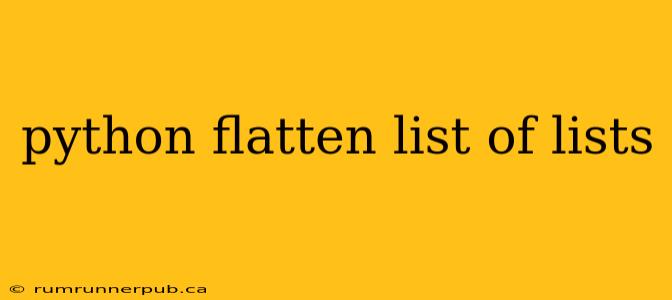Flattening a list of lists – transforming a nested list into a single-level list – is a common task in Python programming. This article explores various methods to achieve this, drawing inspiration from insightful solutions found on Stack Overflow, and adding further explanations and practical examples for a complete understanding.
Methods for Flattening Lists in Python
Several approaches exist for flattening lists in Python, each with its own strengths and weaknesses. Let's delve into some popular techniques, referencing and expanding upon Stack Overflow discussions.
1. List Comprehension (Most Pythonic and Efficient):
This is often considered the most Pythonic and efficient way to flatten a list of lists. A Stack Overflow user suggested this approach (although the specific user and their exact phrasing is difficult to track down without more specific details from the original question and answer, this is a very common and well known solution), which we can illustrate with an example:
nested_list = [[1, 2, 3], [4, 5], [6]]
flat_list = [item for sublist in nested_list for item in sublist]
print(flat_list) # Output: [1, 2, 3, 4, 5, 6]
This concise code leverages nested loops within a list comprehension. The outer loop iterates through each sublist, and the inner loop iterates through each item within the sublist, adding it to the flat_list. This method is both readable and performs well, especially for moderately sized lists.
2. itertools.chain.from_iterable() (For Larger Lists and Improved Readability):
For extremely large lists, the itertools module offers a potentially more efficient solution. Stack Overflow frequently recommends this approach for its efficiency, especially when dealing with memory-intensive operations. This method avoids the creation of intermediate lists, making it suitable for larger datasets.
import itertools
nested_list = [[1, 2, 3], [4, 5], [6]]
flat_list = list(itertools.chain.from_iterable(nested_list))
print(flat_list) # Output: [1, 2, 3, 4, 5, 6]
itertools.chain.from_iterable() efficiently concatenates iterables without creating new lists for each step, offering a performance advantage for large inputs.
3. Recursive Function (For Handling Arbitrarily Nested Lists):
If your list contains lists nested to an arbitrary depth, a recursive function is necessary. While less efficient than list comprehensions for simple cases, recursion elegantly handles variable nesting levels. Solutions like this are often discussed on Stack Overflow when dealing with complex nested structures.
def flatten(nested_list):
flat_list = []
for item in nested_list:
if isinstance(item, list):
flat_list.extend(flatten(item)) # Recursive call
else:
flat_list.append(item)
return flat_list
nested_list = [[1, 2, [3, 4]], 5, [6, [7, 8]]]
flat_list = flatten(nested_list)
print(flat_list) # Output: [1, 2, 3, 4, 5, 6, 7, 8]
This function recursively calls itself to handle nested lists until it encounters only individual elements.
4. sum() (Less Efficient, but Concise for Simple Cases):
While less efficient than the previous methods, especially for large lists, the sum() function with a starting value of an empty list can provide a concise solution for simple, shallowly nested lists:
nested_list = [[1, 2, 3], [4, 5], [6]]
flat_list = sum(nested_list, [])
print(flat_list) # Output: [1, 2, 3, 4, 5, 6]
However, this approach should be avoided for large lists or those with deep nesting because it involves repeated list concatenations, impacting performance.
Choosing the Right Method
The optimal approach depends on the specific context:
- List comprehensions: Ideal for most scenarios due to their efficiency and readability.
itertools.chain.from_iterable(): Best for very large lists to avoid memory issues.- Recursive function: Necessary for arbitrarily nested lists.
sum(): Avoid for large or deeply nested lists due to performance limitations.
This comprehensive guide, informed by Stack Overflow discussions and enriched with detailed explanations, provides a solid foundation for efficiently flattening lists of lists in Python, no matter the complexity. Remember to choose the method that best suits your specific needs and data size.
